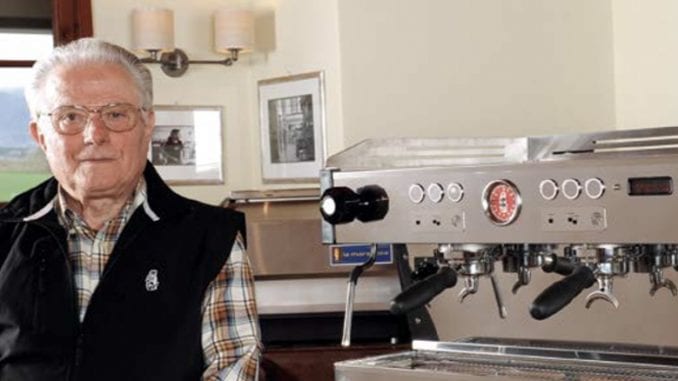
The coffee world loses an icon.
BY SARAH ALLEN
BARISTA MAGAZINE
Cover photo by Sarah Allen
There are only a handful of people who have been as universally loved in the specialty-coffee industry as Piero Bambi of La Marzocco, who passed in the early hours of March 22 at the age of 86. The global La Marzocco family, and Piero’s wife, Giovanna, have designated March 23 as a day of mourning for this insurmountable loss. We at Barista Magazine invite you to join us in remembering and honoring this lifelong specialty-coffee industry legend.
The son and nephew of the company founders, Piero ran the Florence, Italy-based boutique espresso-machine operation almost his entire life, from when he was a boy of 6 polishing parts at his father and uncle’s feet, to just weeks ago in the position of Honorary President. Up until the end, Piero spent most days at the factory.
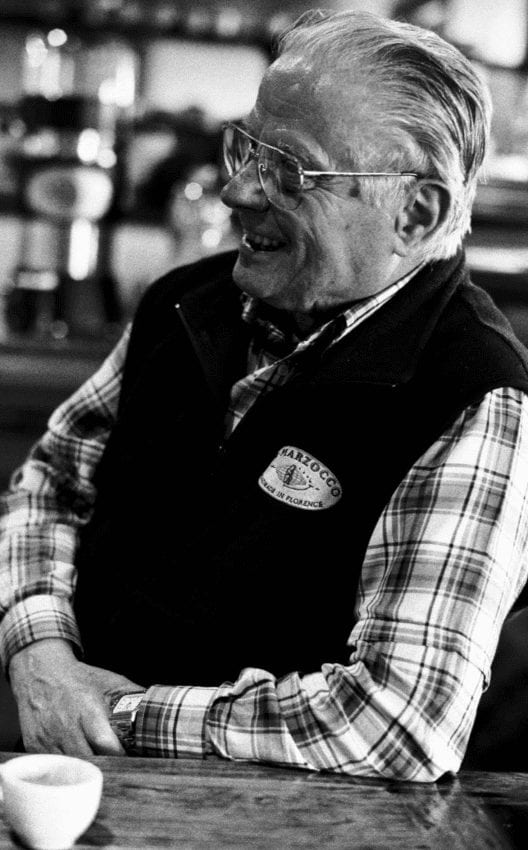
Crafting exceptional machines that exquisitely marry form and function—which is La Marzocco’s legacy—was in the Bambi blood: Piero’s grandfather, Ettore, was a steel worker, and Piero’s father, Giuseppe, had similar interests, becoming an industrial technician and landing a high-ranking job right out of school. “However, his independent spirit, strength, and inborn urge to be ‘innovative’ soon prompted him to leave the plant and start up his own business,” Piero said in an interview in a company publication.
Piero easily fell into step with the heritage established by his father and uncle, Bruno, for breaking boundaries and rewriting the rules. La Marzocco developed the first espresso machine with a horizontal boiler and the first semi-automatic group machine in 1939. Piero himself conceived of and patented the double boiler in 1970, allowing baristas the option of continuous brewing for the first time, which solved a number of problems. “The enormous advantage of continuous brewing is that water drips from the water pipes directly onto ground coffee—which explains the expression ‘continuous brewing,’” he said. “Such a process, coupled with a good thermal balance at an optimal temperature, avoids the accumulation of heat when the machine is used most. In the past, when a barista needed to prepare several espressos in a very short time, the machine would overheat quite rapidly.”
With such a technical mind and an instinctive understanding of not only how espresso machines do work, but how they should work, Piero had a hand in the conception, design, and engineering of almost every La Marzocco machine currently in production. The Linea Classic was the first machine for which Piero led design, and it went on to become the company’s most popular and cherished machine. When the much-anticipated update to this definitive espresso machine was released in 2013—called the Linea PB in Piero’s honor—it was heralded by the Linea Love Campaign, wherein baristas and café owners for whom the Linea Classic played a significant part in their development as professionals shared their fondest memories of the Linea online.
Piero was beloved not only for his exceptional contributions to espresso machine engineering, however. His passion for his work was motivated by a forward-thinking understanding of the challenges and triumphs of the barista. Because of this, La Marzocco was among the first companies to champion the barista as a professional, rather than a transitory service worker. Before it was fashionable, La Marzocco wanted to hear what baristas thought about how coffee equipment could be improved; while today there are many well-known baristas who consult with coffee equipment companies, this was hardly the case 15 years ago—with the exception of Piero and La Marzocco. “The direct contact with baristas when out selling the machines played a fundamental role in developing their passion in light of the suggestions, comments, and constructive criticism provided by the baristas themselves,” Piero explained.
On a spectacular autumn day in 2013 at the La Marzocco factory in Scarperia, just outside of Florence, I was lucky enough to spend the day with Piero for an interview for Barista Magazine. The company’s idyllic setting is no accident; in fact, the famous La Marzocco lion (“Marzocco” comes from Mars, the Roman god of war) acts as a symbol of the people’s power, and was adopted by the Florentines upon the advent of Christianity. “I think the environment you grow up in strongly influences your cultural growth at an unconscious level,” Piero said. “My family was definitely influenced by Florence, the city of art par excellence where they were surrounded by timeless works of unique beauty created by self-made artists and artisans, a tradition that has continued over the centuries and that has very rarely engaged in large-scale production because the terms ‘art’ and ‘craftsmanship’ were inscribed in the artisan genes.”
Days before this, I was with Piero and the La Marzocco family 180 miles southeast of Florence in Milan, for the legendary La Marzocco Out of the Box (OOTB) event, held concurrent with the massive HOST MILAN hospitality show. That OOTB was everything HOST is not: it was intimate and informal, collaborative and innovative. Baristas, café owners, and roasters from around the world came together at OOTB for two days of workshops, lectures, and revelry—and in 2013, for something extra special.
After three years of planning and work kept secret from Piero, the staff unveiled a replica of the original La Marzocco “shop window” van. The first van, built on an Alfa Romeo motor and chassis, was designed by Piero’s father, but was lost in an accident in the 1960s. Created in the exact likeness of the original van, the reproduction—revealed to Piero on the first night of the OOTB event—brought Piero to tears. He spent the duration of the party that followed the van’s presentation behind the wheel inside, talking for hours with the engineers and mechanics who built it.
Piero and his wife, Giovanna, never had any children, which is perhaps part of the reason he insisted on nurturing La Marzocco’s family environment. Most people who work in the factory in Italy work there for the entirety of their careers, not only because the work is rewarding, but also because the atmosphere is so friendly.
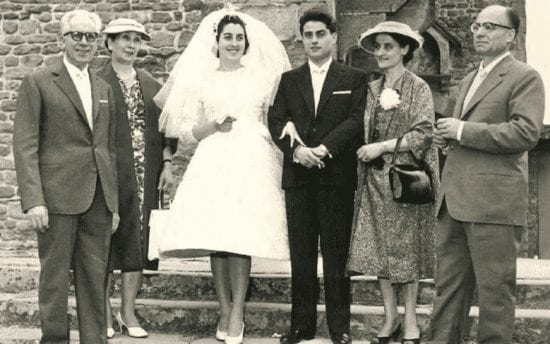
I’ve been lucky enough to visit the factory a handful of times and tour all of it, from the remarkable showroom packed with vintage Marzoccos, to the humming research and development department, to the floor, where machines are put together by hand, piece by intricate piece. Touring at Piero’s side, however, was totally different. Every contraption has a story, and every person, a special history—he told me them all. It was an unforgettable experience.
That day, we lingered on the veranda overlooking the Tuscan countryside, and he began to talk about Kent—Kent Bakke, that is, who was Piero’s business partner and for all intents and purposes, his brother.
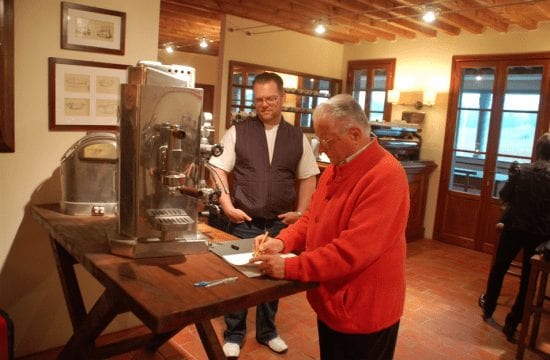
Kent traveled from Seattle to visit La Marzocco’s headquarters for the first time in 1978. “This gave way to a fruitful commercial relationship with the U.S. which was further developed,” Piero said. Their friendship flourished, as well, and the relationship between La Marzocco and Kent resulted in exponential visibility in the United States.
When Piero’s father passed away in 1987, however, Piero’s world changed dramatically. He suffered a heart attack a year later, and his doctor attributed it to Piero’s intense workload and stress level as he assumed responsibility after his father’s death.
“I began reflecting on what I could do to ensure that La Marzocco would continue doing business, especially in light of the fact that the company had been founded by my father, without being affected by [health] problems,” he said. “I initiated negotiations with Kent about the option of selling the company, making it possible to continue doing business in the future. I was not so much interested in the financial gain as in the life of the company itself, in the future of the employees, the continued use of the factory building itself, the brand, etc. In 1994, we reached an agreement, transferring the majority of the company shares to Kent himself.”
Meanwhile, Starbucks was knocking on La Marzocco’s door. Kent had forged a relationship with the famous coffee business already, and it was asking for more and more La Marzocco machines. “At that time, the company produced and sold a limited number of machines per year, and none were in stock,” Piero says. “At the same time, Starbucks was growing very rapidly, making it difficult to maintain our business with them.”
Thankfully, Piero and Kent understood the importance of keeping up with that demand, and they began restructuring La Marzocco. Big things started happening: La Marzocco began sponsoring the World Barista Championship, “which was just being launched and which very few companies had faith in, at least at first,” he says. “This decision, together with the functionality of the Linea series, substantially increased company sales, especially in foreign markets.”
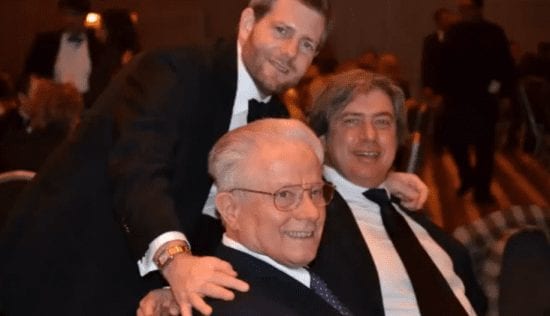
This was a long time coming: “Beginning in 1995, La Marzocco’s corporate structure was deeply reorganized,” he continued. “Its production department, its management, and its assistance services were all improved. The company took on highly qualified technicians and bilingual personnel to further promote its business with foreign markets. … Roberto Bianchi, a mechanical engineer, entered the company, with previous experience in the field. … Through Joe Monaghan, a friend and La Marzocco share holder, Ron Cook [an American who had been working for La Marzocco in a leadership capacity since 1995], met Guido Berardinelli and Lorenzo Carboni, who would eventually open the company’s sales and marketing office in Milan in 2002.”
Since then, Guido and Lorenzo have become tightly woven into the fabric of La Marzocco: Lorenzo opened the company’s London office in October of 2012, and Guido now serves as La Marzocco’s CEO.
Even after Piero’s passing, however, La Marzocco remains a boutique espresso equipment company—a family company. Piero made certain of that.
That autumn day in 2013 when we ambled across the building, I remember how Piero greeted everyone we passed and called them by name. His smile was enormous. “This company belongs to a great many people in spirit,” he told me, straightening in his black La Marzocco fleece vest. “All of us, yes, but to baristas, most importantly.”

ABOUT THE AUTHOR
Sarah Allen is the co-founder and editor in chief of Barista Magazine.

